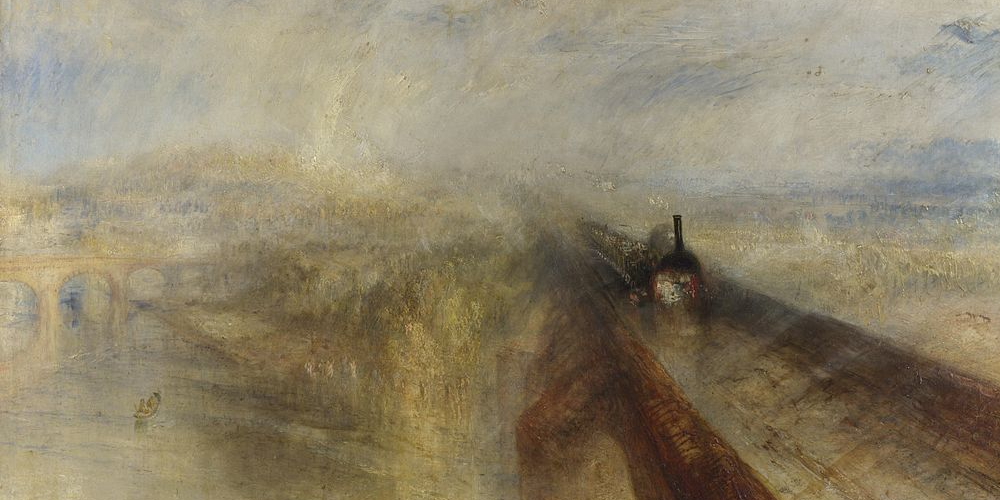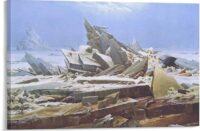In 19th-century England, a new realism in painting emerged, driven by the country’s advanced capitalist development compared to the European continent. Landscape painting became the hallmark of this realism, particularly with William Turner (1775–1851).
Turner’s work sought to capture the immense forces of nature while reflecting social transformations. A lifelong fascination with inventions, politics, and science shaped his technique and thematic concerns. Beyond landscapes, he was captivated by machines and industry, becoming the first painter to integrate the Industrial Revolution into landscape art.
One of his most famous paintings, Rain, Steam, and Speed – The Great Western Railway (1844), captures steam power as a defining force of the Industrial Revolution. As Engels noted in The Condition of the Working Class in England (1845), the steam engine and mechanised industry reshaped society, giving rise to the proletariat. The railway revolutionised perceptions of distance, speed, and time, enabling unprecedented mobility. Greenwich Mean Time was introduced to standardise schedules across the country, and Turner encapsulated these radical changes in his groundbreaking painting.
The Great Western Railway, designed by engineer Isambard Kingdom Brunel, connected London to Bristol. At the painting’s centre is the Firefly locomotive, introduced in 1841 and capable of reaching 50–60 mph (80–100 km/h). The train, racing through torrential rain, dominates the scene as it crosses Maidenhead Bridge: an engineering marvel with the widest and flattest arches ever built at the time. Turner became the first artist to depict the speed of a moving train on canvas. The locomotive rushes forward like a fiery abyss, enhanced by the dramatic diagonal composition. The contrast between the train’s massive iron body and the swirling, rain-laden atmosphere intensifies the sense of motion. Fleeting sunlight pierces the storm clouds, while the blurred landscape dissolves into a haze of speed and rain. The smokestack, the only sharply focused element, glows with reflected light, while the boiler, burning brightly, amplifies the scene’s raw energy. Behind this mechanical beast, third-class passengers huddle in open-air carriages, exposed to the elements.
The painting’s title subtly references an 1841 railway disaster, where a train derailed due to a landslide caused by heavy rain, killing eight and injuring seventeen third-class passengers. A hare in the foreground—often symbolising misfortune—may reinforce the dangers of modern technology. Turner juxtaposes the railway’s impact on the landscape: an old, unused stone bridge from 1770 contrasts with the bustling railway bridge, marking the shift from past to present. The train’s diagonal trajectory, trailing steam, emphasises speed, while the barely discernible hare, England’s fastest land animal, vainly attempts to outrun it. A horse-drawn plough in the opposite direction underscores the transition from traditional labour to industrialisation. On the left, ghostlike figures dance near the river, obscured by steam, while a small boat drifts below, further highlighting the locomotive’s unstoppable progress.
Every element intensifies the sensation of relentless modernisation. The train cuts through the canvas, symbolising a divide between past and future. Turner’s swirling brushstrokes mirror the turbulence of industrial change, capturing the relentless pace of progress. Unlike a steamship at sea, the railway on iron tracks alters the landscape itself: new transport routes, viaducts, and deforested land. Turner conveys the imposing height of the bridge and the train’s motion with innovative artistic techniques: the hot metal of wheels and rails turns rain into steam, while the darkened sky and mist obscure the landscape. The train driver, stoker, and passengers—mostly workers—are swept up in this technological revolution.
Thackeray praised Turner’s bold, experimental style in Rain, Steam, and Speed, describing the work as dynamic and striking. He noted the real rain and sunshine that create an almost tangible atmosphere, with a train rushing toward the viewer at fifty miles per hour. Thackeray pointed out the unconventional techniques Turner used: the rain made of thick putty, the sunshine created with smeary chrome yellow, and shadows formed with crimson lake and vermilion. The fiery steam engine appeared red, but its exact colours were uncertain, adding to the painting’s unique impact. Thackeray concluded, “The world has never seen anything like this picture.”
Turner’s unacademic style, defined by its expressive brushwork and innovative techniques, played a crucial role in shaping his signature atmospheric effects. He often used brushes, spatulas, and even his hands to blend colours, creating the luminous, glowing hues and striking contrasts of brightness and shadow that characterised his work. Although he sketched and studied scenes on-site, he painted the final works in his studio, capturing vivid sensory impressions and emotional experiences.
In The Communist Manifesto (1848), Marx and Engels described how the bourgeoisie revolutionised the productive forces and transformed social relations:
“The bourgeoisie, during its rule of scarce one hundred years, has created more massive and more colossal productive forces than all preceding generations combined. Subjection of Nature’s forces to man, machinery, application of chemistry to industry and agriculture, steam-navigation, railways, electric telegraphs, clearing of whole continents for cultivation, canalisation of rivers, whole populations conjured out of the ground—what earlier century had even a presentiment that such productive forces slumbered in the lap of social labour?”
Turner gives artistic expression to this power in his railway depiction. His style broke from traditional sharp contours, clear separations of motifs, and rigid compositions. Instead, he developed an innovative approach, capturing phenomena never before seen on canvas. Rather than presenting nature as static, Turner revealed how perception shapes experience. His vision transcends traditional boundaries, placing the interaction between subject and environment at its core. Few works of his time parallel his groundbreaking depictions of steam and industrial transformation.






